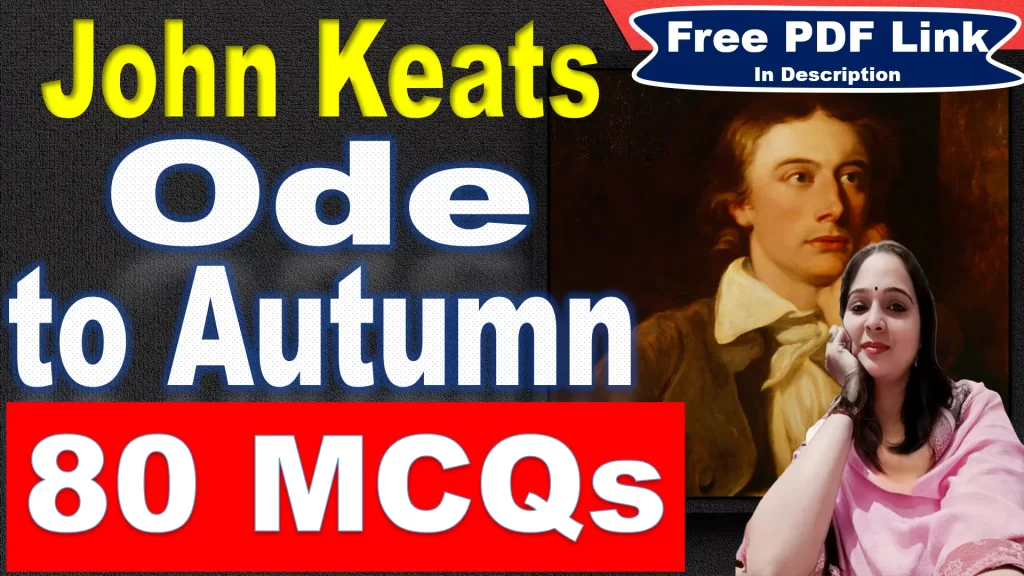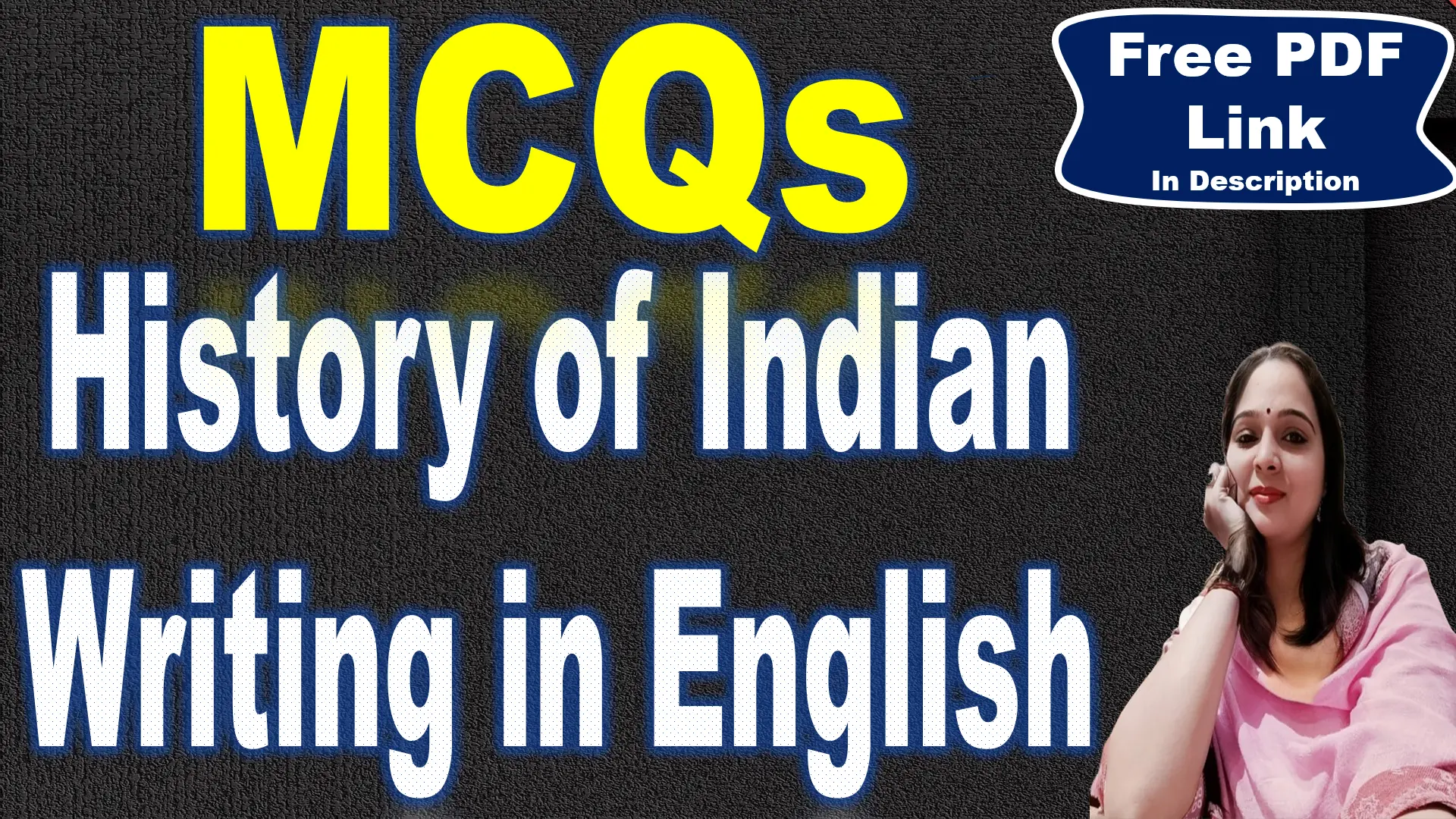
41. Which meter is primarily used in Ode to Autumn?
A) Trochaic tetrameter
B) Iambic pentameter
C) Dactylic hexameter
D) Anapestic trimeter
Answer: B) Iambic pentameter
Explanation: Keats wrote Ode to Autumn in iambic pentameter, meaning each line typically contains ten syllables with alternating unstressed and stressed beats (da-DUM da-DUM da-DUM da-DUM da-DUM). This is one of the most common meters in English poetry, used in Shakespeare’s sonnets and Milton’s Paradise Lost. The steady rhythm gives the poem a natural and flowing feel, enhancing its gentle and reflective mood.
42. In which collection was Ode to Autumn published?
A) Endymion and Other Poems
B) Lamia, Isabella, The Eve of St. Agnes, and Other Poems
C) Poems by John Keats
D) Hyperion and Other Odes
Answer: B) Lamia, Isabella, The Eve of St. Agnes, and Other Poems
Explanation: Keats included Ode to Autumn in his 1820 collection titled “Lamia, Isabella, The Eve of St. Agnes, and Other Poems”. This collection featured many of his most famous works, marking the peak of his poetic career. Though Keats was already suffering from tuberculosis, his writing during this period was some of his finest. Despite receiving praise, Keats’ poetry did not gain widespread recognition until after his death.
43. Which of the following is a distinctive feature of the structure of Ode to Autumn?
A) Each stanza focuses on a different aspect of autumn
B) The poem lacks a rhyme scheme
C) The poem consists of a single continuous thought
D) The poem contains dialogue between two characters
Answer: A) Each stanza focuses on a different aspect of autumn
Explanation: Each stanza in Ode to Autumn presents a different perspective on the season:
First stanza: Focuses on abundance, showing fruits, grains, and flowers at their peak.
Second stanza: Personifies autumn as a harvester, watching over the ripening crops.
Third stanza: Describes autumn’s sounds, marking the transition to winter.
This structured progression mirrors the passage of time within the season, giving the poem a natural and harmonious flow.
44. When was John Keats born?
A) 1795
B) 1801
C) 1810
D) 1789
Answer: A) 1795
Explanation: John Keats was born on October 31, 1795, in London, England. He grew up in a modest family and faced many hardships at a young age, including the early deaths of both his parents. Despite these struggles, Keats developed a passion for poetry and literature. His short but highly influential career established him as one of the greatest poets of the Romantic era. Though he died young, his works have left a lasting legacy in English literature.
45. John Keats was a poet of which literary movement?
A) Victorian
B) Romantic
C) Modernist
D) Renaissance
Answer: B) Romantic
Explanation: Keats was one of the most important poets of the Romantic movement, which emphasized emotion, nature, imagination, and individualism. Romantic poets, including Wordsworth, Shelley, and Byron, focused on personal experiences, intense emotions, and the beauty of nature. Keats’ poetry is particularly known for its rich sensory imagery and deep appreciation of beauty, as seen in poems like Ode to a Nightingale and Ode to Autumn.
46. What was John Keats’ profession before becoming a full-time poet?
A) Lawyer
B) Doctor
C) Surgeon’s apprentice
D) Teacher
Answer: C) Surgeon’s apprentice
Explanation: Before fully dedicating himself to poetry, Keats trained as a surgeon’s apprentice. He studied medicine at Guy’s Hospital in London and became skilled in medical procedures and surgery. However, despite his talent in the medical field, Keats’ love for poetry was stronger. He eventually decided to abandon medicine and pursue his passion for writing. This decision was risky, as poetry did not provide financial security, but it allowed him to create some of the most beautiful poems in English literature.
47. Which of the following is NOT written by John Keats?
A) Ode to a Nightingale
B) Ode to the West Wind
C) Ode on a Grecian Urn
D) Endymion
Answer: B) Ode to the West Wind
Explanation: Keats is famous for writing several great odes, including Ode to a Nightingale, Ode on a Grecian Urn, and Ode to Autumn. However, Ode to the West Wind was written by Percy Bysshe Shelley, another major Romantic poet. Shelley’s poem focuses on change and revolution, using the wind as a metaphor for transformation. While both Keats and Shelley were part of the Romantic movement, Keats focused more on sensory beauty, while Shelley often addressed political and philosophical themes.
48. In which year did John Keats die?
A) 1819
B) 1821
C) 1830
D) 1845
Answer: B) 1821
Explanation: John Keats passed away on February 23, 1821, at the young age of 25. His death was a tragic loss to the world of literature. Despite his short life, he produced a remarkable body of work that continues to inspire poets and readers today. Keats’ final years were filled with personal and financial struggles, yet he never lost his passion for poetry. His works became widely appreciated only after his death, and he is now regarded as one of the greatest English poets.
49. Where did John Keats die?
A) London
B) Paris
C) Rome
D) Florence
Answer: C) Rome
Explanation: Keats traveled to Rome, Italy, in 1820 in search of a warmer climate to help with his declining health. At the time, tuberculosis had no cure, and doctors believed that a milder climate might improve his condition. Unfortunately, his health continued to deteriorate, and he died in a small apartment near the Spanish Steps. Today, his house in Rome is preserved as the Keats-Shelley Memorial House, visited by literature lovers from around the world.
50. What caused John Keats’ death?
A) Pneumonia
B) Tuberculosis
C) Cholera
D) Heart failure
Answer: B) Tuberculosis
Explanation: Keats suffered from tuberculosis (TB), a deadly disease at the time. His mother and younger brother had also died from TB, and despite seeking treatment, Keats could not recover. The disease severely affected his lungs, causing coughing, fever, and weakness. In his final months, Keats was cared for by his close friend Joseph Severn, who was with him until his death. His tragic illness and untimely death added to his romantic and legendary status in literature.
51. Which famous phrase is inscribed on John Keats’ tombstone?
A) “Here lies one whose name was writ in water.”
B) “A thing of beauty is a joy forever.”
C) “Truth is beauty, beauty truth.”
D) “To see a world in a grain of sand.”
Answer: A) “Here lies one whose name was writ in water.”
Explanation: Before he died, Keats requested that his tombstone bear the inscription “Here lies one whose name was writ in water”. He believed that he would not be remembered after his death, reflecting his deep sadness and insecurity about his legacy. However, he was mistaken—his poetry gained immense recognition after his death, and he is now celebrated as one of the greatest poets of the English language. His grave is in the Protestant Cemetery in Rome, where many visitors pay tribute to him.
52. What was the name of John Keats’ fiancée?
A) Fanny Brawne
B) Mary Shelley
C) Charlotte Smith
D) Elizabeth Barrett
Answer: A) Fanny Brawne
Explanation: John Keats was engaged to Fanny Brawne, a young woman he deeply loved.
They met in 1818 and became engaged in 1819, around the same time Keats wrote his famous odes, including Ode to Autumn.
Their love was passionate but tragic, as Keats’ declining health (due to tuberculosis) prevented them from marrying.
In 1820, Keats traveled to Rome in hopes of recovering, but he never saw Fanny again before his death in 1821.
Fanny mourned Keats deeply and wore a mourning ring with his hair for many years.
53. What literary device is used in “Close bosom-friend of the maturing sun”?
A) Simile
B) Personification
C) Hyperbole
D) Oxymoron
Answer: B) Personification
Explanation: The literary device used in “Close bosom-friend of the maturing sun” from John Keats’ “Ode to Autumn” is personification.
In this line from the first stanza, Autumn is described as a “close bosom-friend” of the sun, which is itself characterized as “maturing.” Both Autumn and the sun are given human qualities: Autumn as a friend—implying companionship and intimacy—and the sun as maturing, suggesting a human-like process of growth or aging. Personification occurs when non-human entities, like seasons or celestial bodies, are endowed with human traits or relationships, as Keats does here to emphasize their collaborative role in ripening the harvest.
A) Simile: This requires “like” or “as” for comparison (e.g., “friend like the sun”), which isn’t present.
B) Personification: Correct, as Autumn and the sun are humanized as friends.
C) Hyperbole: This involves exaggeration (e.g., “best friend forever”), but the phrase is understated, not overstated.
D) Oxymoron: This pairs contradictory terms (e.g., “bitter-sweet”), but “close bosom-friend” and “maturing sun” aren’t opposites.
54. Which literary device is used in the line “Thy hair soft-lifted by the winnowing wind”?
A) Oxymoron
B) Metaphor
C) Personification
D) Simile
Answer: C) Personification
Explanation: The literary device used in the line “Thy hair soft-lifted by the winnowing wind” from John Keats’ “Ode to Autumn” is personification.
This line, from the second stanza, addresses Autumn directly (“thy”) and describes it as having “hair” that is “soft-lifted” by the wind. Personification occurs when a non-human entity—here, the season of Autumn—is given human characteristics, such as possessing hair, which is gently moved by the wind. The “winnowing wind” (separating grain from chaff) further ties this to a harvest scene, but the key device is Autumn’s humanization.
A) Oxymoron: This involves contradictory terms (e.g., “deafening silence”), but “soft-lifted” and “winnowing wind” aren’t opposites.
B) Metaphor: This is a direct comparison (e.g., “thy hair is a golden wave”), but the line doesn’t equate hair to something else—it simply attributes it to Autumn.
C) Personification: Correct, as Autumn is given human hair and the action of it being lifted.
D) Simile: This uses “like” or “as” (e.g., “hair lifted like a breeze”), but no such comparison appears here.
55. The phrase “barred clouds bloom the soft-dying day” is an example of which literary device?
A) Oxymoron
B) Simile
C) Personification
D) None
Answer: C) Personification
Explanation: In this line, the day is personified as if it were a living thing that is dying softly. The phrase “barred clouds bloom” suggests that the clouds in the sky at sunset appear like flowers blossoming, making the fading sunlight seem beautiful rather than sorrowful. Keats transforms the concept of time passing into something graceful and poetic, emphasizing the beauty in change.
56. What literary device is used in the line “And sometimes like a gleaner thou dost keep”?
A) Simile
B) Metaphor
C) Alliteration
D) Irony
Answer: A) Simile
Explanation: A simile is a direct comparison using “like” or “as”. Here, autumn is compared to a gleaner (someone who collects leftover crops after a harvest). This image suggests that autumn is carefully gathering the last remnants of the season, reinforcing its role as a time of completion and fulfillment. The simile gives autumn a human-like quality, making the reader visualize it as a quiet, diligent worker.
57. Which literary device is used in “Then in a wailful choir the small gnats mourn”?
A) Simile
B) Metaphor
C) Personification
D) Hyperbole
Answer: C) Personification
Explanation: Keats personifies the gnats, describing them as if they are singing a sorrowful song. In reality, gnats do not mourn, but the buzzing sound they make is compared to a choir singing sadly. This personification emphasizes the melancholic transition from autumn to winter, where the once vibrant world of nature is now slowing down. It also enhances the auditory imagery in the poem, making the reader almost “hear” the sounds of autumn.
58. The line “For summer has o’er-brimm’d their clammy cells” uses which literary device?
A) Hyperbole
B) Metaphor
C) Simile
D) None
Answer: A) Hyperbole
Explanation: The line “For summer has o’er-brimm’d their clammy cells” from John Keats’ “Ode to Autumn” uses hyperbole as the primary literary device.
Let’s analyze it:
“O’er-brimm’d” means overflowed or filled beyond capacity.
“Clammy cells” refers to the bees’ honeycomb cells, described as moist or sticky.
The full context (first stanza) is: “And still more, later flowers for the bees, / Until they think warm days will never cease, / For summer has o’er-brimm’d their clammy cells.” This suggests Summer has so abundantly filled the bees’ cells with nectar that they believe summer will never end. Hyperbole is exaggeration for effect. Here, “o’er-brimm’d” exaggerates the extent of Summer’s bounty—implying an overflowing abundance beyond what’s realistic—to emphasize nature’s generosity and the bees’ perception of endlessness. While “clammy cells” could hint at metaphor (comparing honeycomb to something clammy), the dominant device is the exaggerated fullness.
59. The phrase “Steady thy laden head across a brook” uses which literary device?
A) Simile
B) Hyperbole
C) Symbolism
D) Personification
Answer: D) Personification
Explanation: Personification is when human qualities are given to non-human things. Here, the heavy plants or stalks of grain are described as having a “laden head” that is bending over a brook. This gives the plants a human-like image, as if they are tired from carrying a heavy load. This depiction reflects the weight of the harvest season, reinforcing the theme of completion and fulfillment.
60. “And touch the stubble-plains with rosy hue” is an example of which literary device?
A) Hyperbole
B) Simile
C) Personification
D) Alliteration
Answer: C) Personification
Explanation: Keats personifies the sunlight as if it is gently touching the fields with its glow. This makes the evening light feel alive, giving it a soft, affectionate presence. Instead of presenting the sunset as a mere event, Keats animates it, reinforcing the theme that nature is active, delicate, and interconnected. The rosy hue also symbolizes the beauty in endings, reflecting autumn’s quiet farewell.





